Octavio Penna Pieranti
University of Brasília
Edilon Esaú Reis
Independent researcher
ABSTRACT
During the Cold War in Europe, mass media from capitalist countries transmitted programmes to socialist nations and disputed local audience. The last ones defended themselves with radio jamming and improved their programmes to attract watchers. But this paper focuses on another type of resistance and its limits – actually, a counterattack: in late 1980s, many TV stations from socialist European countries transmitted to the capitalist nations in the continent. This paper aims to demonstrate how these transmissions were permanently conducted at that time by recreating the coverage maps of those stations, according to their real technical parameters and to geographical conditions. It concludes that some of the TV programmes from socialist countries were received and could be watched in capitalist Europe, despite language and technical barriers. The influence of socialist broadcasters’ programmes in capitalist Europe remains unclear, though.
KEY WORDS
Cold War – TV Broadcasting – coverage – propaganda
History often tells us that Europe was divided in two blocks after the Second World War. The first one, located in the centre-west of the continent, was formed by capitalist countries; the second one, in the centre-east of the continent, was the socialist block (or, depending on the theoretical framework or on the local political speech, the communist block).[i] There were clear political differences both within capitalist and socialist blocks: for example, Albania and Yugoslavia could not be recognized as satellites of the Soviet Union, since both of them adopted their own socialist models. Even the remaining countries agreed in different levels with the Soviet Union: Romania, for example, did not support Soviet Army’s invasion of Czechoslovakia in 1968, where the national government was allegedly trying to construct a “new socialism with a human face.” The differences are also reflect in the media sector, for example with some refusals to join international associations of socialist countries (Albania and Yugoslavia did not join Intersputnik and left the International Radio and Television Organization a few years after its creation) and dissent in the choice of the TV standard (Albania, Romania and Yugoslavia adopted PAL, like most European capitalist countries, while other socialist nations preferred Secam). All these differences are not always pointed out and the socialist block is often wrongly presented as a monolith.
These differences are not the only forgotten point. The most common story of the “propaganda war” between the two blocks also presents some gaps. In a perspective of the “winners” of this (Cold) war, as we will discuss in the next section of the paper, propaganda would help to boost criticism in the Eastern block and would contribute to the fall of the local regimes starting from the late 1980s. But how did the socialist block react against this propaganda? This is the central point here.
With the help of broadcasting, at that time socialist nations could theoretically dispute, in the media field, “brains and hearts” of the society in capitalist countries. This paper aims to present specifically how TV stations from socialist countries could reach the West. To do this, we have recreated the scenario of television in Europe at that time, based on the former technical conditions of TV stations in the socialist block. Using technological tools that were, of course, not available at that time, it was possible to estimate the coverage of the stations and how they reached central-west Europe. This analysis gives us a unique picture of where Eastern TV signals were available at that time.
To qualify this approach to the West as a “counterattack,” as mentioned in the title of the paper, and discuss its limits, we focus on some auxiliary issues: did the socialist countries really broadcast to capitalist ones? If yes, which nations and areas could they reach? Were the audience able to receive the signals and watch the programmes? And did the audience really watch them?
By now, we can mention that the first issues are discussed in the next pages. It is important to mention, though, that this paper could not verify the influence of these transmissions since it was not possible to find reliable audience data. Also, it does not debate a potential policy related to the content transmitted, i.e., if and how the socialist governments and the broadcasters oriented their programmes to be more interesting to western audience. As it will be described, many authors already pointed out that these programmes did not focus only on propaganda, but also on entertainment. Even so, language could be a natural barrier to conquer the public. But the main point of the paper is to prove that the road to the west was built, what means, in this case, that the TV stations were technically able to reach the neighbouring countries.
In the next section, we will briefly describe the transmission of propaganda during the Cold War. Then, we will present the technical criteria related to the stations and the methodology used to verify their coverage. Finally, we will present the analysis of each studied station.
The link between mass media and propaganda to foreign countries was established some decades before TV was in the centre of living rooms in houses around the world. At the beginning of the 20th century, this (physical) position of status was occupied by other big equipment – radio sets that could receive programmes transmitted in medium and shortwaves.
During the First World War, Germany already used radio as a propaganda tool, transmitting programmes to foreign countries. In the 1920s, the Soviet Union began to use this mass media in the same way. In 1939, in the beginning of the Second World War, 25 countries had “international programmes,” i.e. content transmitted to foreign countries. Many of these began to be world famous, like United States’ The Voice of America in 1942. All of the major countries fighting in the Second World War had similar programmes. In the following decades, the problem (or solution, depending on the perspective) grew: in 1983, at least 80 countries used to transmit programmes in more than 30 idioms, and also private radio broadcasters did the same (Krasner, 1991). The listeners of these stations lived, in many cases, miles and continents away from the broadcasters: in Brazil in 1976 it was, for example, possible to listen to BBC, Voice of America and radio stations from Germany, Canada, Japan, Cuba, Soviet Union, China, Sweden, Holland, and Switzerland (Leal Filho, 2008). Some countries – such as Cuba – publicly criticised the transmissions coming from abroad and tried to map their origins (Vivanco, 2006).
The arrival of television represented a new challenge for cross-border transmissions: in a way, sound and image could represent a more convincing scenario for propaganda; in another, due to technical reasons, TV broadcasting signal could not reach as far as shortwaves, unless satellites and Internet were used. In other words, during the period studied in this paper, when more advanced transmission methods did not exist or were not as commonly used as today, it was much more difficult to reach foreign countries with cross-border TV broadcasting – unless these other countries were located only some miles away.
Propaganda, at that time and now, should not be understood as a reunion of explicit political speeches. The key to success can be called “the export of culture,” i.e. the transmission of the content which could interest foreign countries, showing the best each country could offer. Some singers and actors, for example, began to be internationally known due to their common presence in medium and shortwave stations.
Reception of these transmissions in Europe was limited by at least two barriers in the 1980s. Different languages were spoken in neighbouring countries in most of the cases. But audiences, when interested in the programmes coming from abroad, tried some solutions. In the northern part of Estonia (at that time part of the Soviet Union), for example, some people tried to learn Finnish or buy dictionaries to understand TV programmes broadcasted from Finland (Lepp & Pantti, 2012). In a few cases, the language was not a barrier. In the coastal areas of Yugoslavia, people used to understand Italian as this part of the territory belonged to Italy years before (Rolandi, 2015). Language was not a barrier in Germany after the split of the country, either.
The second barrier that deserves attention was a technical one: potential difficulties to receive foreign signals after the adoption of different colour TV standards in Europe. At that time, countries often used PAL or Secam standards. Each standard could also be configured according to different parameters. Theoretically, this would make it more difficult to watch TV programmes from a country that used a different standard (or the same standard with different parameters).
The simplest solution in this case was to adapt the TV set, which could be done by people who had the appropriate technical skills. This solution was very common in Hungary and Czechoslovakia (Krasner, 1991). In Estonia, the adaptation cost around 40% of the monthly average salary (Lepp & Pantti, 2012). Another solution was the purchase of a multi-standard TV set (enabled to receive both Secam and PAL signals). These were produced already since the 1970s in capitalist Europe and became popular in the early 1980s with the growth of interest in satellite TV and international exchange of tapes containing audio-visual material for domestic use. Soon, they became a commodity (Sharp, 2012). It was impossible to find reliable sources about the availability of these sets in Eastern Europe at that time, but they were quite common in the other part of the continent. Therefore, during the 1980s, it was possible to receive, in an appropriated way, Secam and PAL signals in Western and Eastern Europe.
Watching foreign TV programmes, in a way or another, was common in the 1980s in Europe. For example, in Romania (PAL standard), depending on the place the viewer lived, it was possible to watch Yugoslavian (PAL), Hungarian, Bulgarian or Soviet programmes (all of them Secam), which worried the government (Mustata, 2011; Bönker & Obertreis, 2016). About one third of Hungarian population could watch Austrian channels – if they adapted their TV sets – and since 1960, Hungarian newspapers even listed Austrian channels. Italian channels were received in Albania (Jakubowicz, 1994).
Italian RAI played a specific role in Eastern Europe. In the first phase of Yugoslavian TV, from the late 1950s until the 1960s, the government decided to transmit some of the RAI contents. Albanian TV broadcasted RAI news in the 1980s. In the same period, due to an agreement with the Polish government, there was even a RAI relay station in Krakow (WRTH, 1990; Carelli, 2014; Rolandi, 2015). However, the RAI’s situation was an exception in terms of its acceptance by socialist governments.
As known, Germany was divided after the war: the western part of its territory and the western part of former capital Berlin formed capitalist Federal Republic of Germany (FRG) and the eastern part of it, including the eastern part of Berlin, formed socialist German Democratic Republic (GDR). In the 1960s, Berlin was divided by a wall and soon each side of the city was trying to reach the other one via air waves. International actors played their role in the scene, like, for example, Radio Free Europe and Radio Free Berlin. Also television was in the centre of this battle. The analogue standard for black-and-white TV was the same in both German states, but the arrival of colour TV introduced the technical problem already mentioned. FRG stations transmitted in both standards to continue reaching GDR homes, but also the adaptation of TV receivers was an option.
Although public TV from the FRG was a strong competitor, DFF, state-owned TV in the GDR, did not give up. Actually, the national government began to invest in television, when other socialist countries were still focused on radio. In June 1950 (some months before the first TV transmission in Brazil, for example), the government began to build a TV centre in Adlershof, Berlin. In December 1952, in order to celebrate Joseph Stalin’s birthday, the GDR began its TV transmissions of two hours per day. This same year, the FRG began its experimental TV transmission – some steps behind the GDR. After a quick period of expansion of the transmissions in the GDR’s territory, DFF was officially created in January 1956.
DFF2, second programme of the GDR, began to operate in 1969, the same year of the arrival of colour TV in the country (3 years before it arrived, for example, in Brazil). From 1956 to 1989, total TV transmission time grew constantly in the GDR, considering both programmes. In January 1957, the main public service broadcaster in the FRG, ARD, transmitted for 6930 minutes in 31 days, and DFF transmitted for 5335 in 27 days (Heimann, 2006). At that time, DFF did not transmit on Mondays, so the average length of daily transmissions was pretty similar: 233.5 minutes by ARD compared to 197.6 by DFF. Numbers would grow in the following years, mainly due to the creation of DFF2: both channels transmitted during 3007 hours in 1960; 6028 in 1970; and 8900 in 1989. The GDR’s TV also opened its schedule for foreign content progressively: in 1964, it represented 35% of total transmission time and 45% in 1972. The increase was related to DFF’s foreign policy. In the 1970s, the station celebrated commercial agreements with broadcasters from more than 70 countries. The main partner in the socialist bloc was the Soviet Union and, in the capitalist bloc, its main rival, the Federal Republic of Germany. Most of the foreign content transmitted in the GDR was related to sports, international politics and entertainment (Beutelschmidt & Oehmig, 2014).
Despite the efforts of DFF, the competition with ARD was unbalanced already in the 1960s. In 1966, public television in the FRG had 20 studios and 10,775 employees; in the GDR, state-owned TV had one studio and 2,354 employees. The annual budget of ARD was 1.11 billion FRG Marks; the budget of DFF, 127 million GDR Marks. (Officially, both currencies had the same value, but in daily life, at that time, 1 FRG Mark from could be exchanged for 4 GDR Marks.) In 1982, DFF’s average audience reach was estimated at 33% while at the end of 1989, its main TV newscast had an audience reach of around 4% (Beutelschmidt, 2001; Dittmar, 2005).
The competition in radio was even harder. Deutsche Welle from the FRG began to transmit in 1953 and soon was operating in 29 idioms and could be heard in a huge part of the world. In 1992, after the collapse of socialism, Deutsche Welle created its TV channel, as it incorporated professionals and infrastructure from RIAS-TV, the TV channel used by North American USIA to transmit propaganda to the socialist bloc in previous years. RIAS-TV lost its purpose with the end of the Cold War, after acting as a powerful propaganda tool over the decades (Chalaby, 2010).
The socialist countries broadcasters had to dispute audience not only against European capitalist countries, but also against stations maintained by the United States. And they had fewer resources than their adversaries, as well as problems in accessing new technologies. How could the socialist bloc resist? The literature presents, as explained in following pages, at least two answers and this paper focuses on a third one.
The first answer: in order to deal with the undesired (by the government) foreign broadcasters, mainly radio stations, the socialist bloc tried to block their signals, so they could not reach the listeners. This procedure was world-known as radio jamming and was adopted by many governments despite their political orientation. For example, the Soviet Union implemented radio jamming already the 1930s; Austria, Germany and Italy, during the whole Second World War; Spain during Franco’s dictatorship; South and North Korea utilize it until now. Sometimes this practice fails, since the transmissions technical parameters can also be changed. Propaganda stations, which wanted to reach the Soviet Union, used more than 60 different frequencies, so it was practically impossible to block all of them for all the time, considering technological tools available at that period (Krasner, 1991).
The second form of resistance was the shift of the domestic policy related to the programmes. Sometimes the programmes of socialist countries are imagined by common sense as pure propaganda, but this was not completely true. The change of focus should not be seen only as a consequence of capitalist TV threat; actually, it was a matter of improving credibility and attractiveness of TV in socialist countries. In order to be accepted, state-owned broadcasters had to move beyond propaganda, changing the type of content that were transmitted.
Socialist leaders seemed to notice that competition in mass communications was inevitable. So, national TV should not only focus on propaganda, but should be as attractive as possible. Erich Honecker, Prime Minister of GDR, described DFF at a party’s convention as boring and defended the idea that DFF should focus on entertainment. In the same period, the structure responsible for the supervision of broadcasting was remodelled and TV was more open to other types of contents (Dittmar, 2005; Kochanowsky, Trültzsch & Viehoff, 2012). In the Soviet Union, Leonid Brezhnev also demanded more entertainment in national TV and reminded that “the Soviet person has the right to relax in front of the television after a day’s work” (Mihelj, 2012, p. 18). In Romania, during the 1960 decade, in the so-called “romantic” phase, it was accepted that TV should educate and entertain. Foreign approved content and even investigative journalism (with limits) were welcome (Mustata, 2012; Surugiu, 2016). In Czechoslovakia, during “normalisation” period, TV was intended to show an everyday life without surprises – drama and serials were supposedly effective to draw this scenario on the screens (Reifová, 2015).
The reshaping of East European TV, including a certain degree of (limited) media independence, varied from country to country and, in the same nation, from a political phase to another one (Becker, 2004). In most socialist countries, this process involved an opening to foreign content, which was influenced by some initial steps of globalisation in mass communications. The first satellite, Sputnik, launched in 1957, and its success suggested that soon it would be possible to advance with the exchange of content by broadcasters worldwide, as well as with live transmissions. For national audiences, this new situation represented the possibility of access of different types of programmes. In the 1960s, socialist countries began – in a very cautious way – to license foreign and national programmes related to popular culture, invested in sports events and dramaturgy while keeping the transmission of educative material, which were always present in television of socialist countries since its birth (Imre, 2012). In the following years, the broadcasters of these countries maintained this tendency. Lassie became popular in Yugoslavia; Flipper, Joe Mannix and Chicago, in Romania; Forsythe Saga and David Copperfield in the Soviet Union; and Zorro, Mickey Mouse Club and Disneyland in Poland (Mihelj, 2012). It was estimated that at the beginning of 1980s 43% of imported programmes in this part of the continent were produced by broadcasters from Western Europe – compared to 45% produced by broadcasters from socialist countries (Mihelj, 2014).
In 1989, in some of the East European countries’ total transmission time was comparable to the ones observed in capitalist countries, as shown in the table below:
Table 1: Transmission time from state-owned and public TV stations (1989)
|
Country |
Number of Nat. Programmes |
Hours/week (1st Programme) |
|
Albania |
1 |
32h 30m |
|
Bulgaria |
2 |
70h |
|
Czechoslovakia |
2 |
97 h |
|
FRG |
2 |
115 h 30 m |
|
GDR |
2 |
105 h |
|
Greece |
2 |
56 h |
|
Hungary |
2 |
74 h |
|
Italy |
3 |
85 h 30 m |
|
Poland |
2 |
81 h |
|
Portugal |
2 |
85 h |
|
Romania |
1 |
22 h |
|
Soviet Union |
5 |
60 h |
|
United Kingdom |
2 |
120 h |
|
Yugoslavia (Slovenia) |
1 |
108 h 30 m |
Source: Elaborated by the authors, based on WRTH (1990).
Besides the total transmission time, the plurality of TV channels also varied among socialist countries. In Yugoslavia, there were nine TV programmes, one for each Republic and three designed for specific social groups (Kresic, 2012). At the same time, Romanian government decided to discontinue the second TV programme and the first one was aired only for two hours during weekdays (Marinescu, 1995).
So, the first 2 forms of resistance against foreign mass media were radio jamming and the complete reshape of the programmes in socialist countries, in order to be hopefully more accepted by the society. And this paper, as already mentioned, will add a third one, which could be called a “counterattack”: direct transmission of free-to-air TV to capitalist countries. Before presenting it and discussing its limits, it is important to explain the methodology and the technical parameters used to estimate the coverage of TV stations from socialist countries.
First of all, it is important to reiterate that this research could only be done with the use of the current advanced technological tools. In 1989, when the TV stations mentioned here were in operation, the estimation of the coverage frequently involved a lot of calculations and the plotting of the stations on physical maps, except for big companies that could automatize part of this work. In 2017, the authors of this paper used Radio Mobile, a software which is available on the Internet, to plot the stations and estimate their coverage with the help of Google Earth.
To select the sample, the authors localised 208 stations, which were theoretically functioning in 1989 in nine countries: in Albania, Bulgaria, Czechoslovakia, the German Democratic Republic, Hungary, Poland, Romania, the Soviet Union and Yugoslavia. Then 67 of these were plotted and had their coverage verified. This group was selected, based on the proximity of the stations to the borders of the countries and on their power of operation. Finally, a group of 11 are presented in the next section of this paper.
The key point to reach this research’s objective was to “recreate” Europe in 1989, in technical terms, as perfect as possible. Multiple technical parameters can influence the TV station’s coverage, so we aimed to be careful in using real conditions observed at the continent, as described below, and according to the international guidelines and regulations of the broadcasting sector. It is important to mention that a coverage map is always an estimation, and it is always unsure if all TV sets in the selected region will be able to receive the signal. (A tall building, for example, can prevent the TV sets in near houses to receive it, etc.) Nonetheless, good coverage maps are considered precise enough to be accepted by broadcasters, regulators, government and researchers.
In order to verify the coverage of a station, it is necessary to know its technical parameters. For this paper, it is necessary to know these parameters, as they were defined in the late 1980s, before the socialist regimes ended. More than 25 years after their fall, a lot of information regarding their communications systems has been lost or cannot be publicly found on the Internet. Fortunately, it was possible to access World Radio TV Handbook 1990, an important database published since 1947, containing technical details of TV and radio stations worldwide. So, the city of operation, channel and power of the mentioned TV stations in this paper were adopted as described in the 1990 version of the handbook, which presented information from 1989 – the same year the socialist regimes began to collapse.
The coverage of a specific station depends on its frequency band, which is translated into a channel of operation. The frequencies related to each channel vary internationally depending on technical plans of each country. For example, channels No. 2 of the analogue TV in Brazil, the United States and in Europe do not necessarily use the same frequencies. Two solutions were adopted: (a) the adoption of the International Radio and Television Organization (OIRT) members frequency plans, which included socialist countries as described in World Radio TV Handbook 1990, and (b) a comparison with Brazilian (and other countries) frequency plans, that define 6 MHz-band channels. The coverage of the stations was quite similar in both cases and the differences would not cause any harm to the analysis. To be more precise, the coverage maps in the following section are based on the frequency plans of OIRT.
To configure the coverage map of TV stations using Radio Mobile, the following parameters have been defined. The parameter “network” has been configured by selecting the frequencies of the lower and upper limits of the television channel for each location. So, as already mentioned, the paper adopted the frequency plans as described for the OIRT members. Among the network configuration parameters, polarisation of the antenna used for signal transmission, the statistical mode, the type of climate for each locality, the average permittivity and the conductivity of soil in that region were also specified, as well as the refractivity of the Earth's surface. Local parameters were adopted for each nation.
The parameter “network topology” was specified as “voice network” and “always visible.” As members of the network, a “fixed station” and a “mobile station” were specified. The fixed station has been designated as the “central station” for which the coverage should be measured. This station was called the “control station.” Coordinates of the fixed stations were centralised in each locality, according to Google Earth. For the “mobile station,” the geographical coordinates in the country closest to the borders with that country were chosen.
The “mobile station” was moved to a fixed point, serving as reference to evaluate the quality of the signal at reception. This station was called the “subordinate station.” The “link direction” was chosen by taking the reference station as a transmitter and the mobile station as the receiver taking into account the worst of both cases. A 30-meters height antenna was used for the control station (fixed station), and for the subordinate station (mobile station) the considered height of the antenna was 10 meters. (These antenna heights are commonly used as ITU references.)
The radiation pattern of the antennas used was chosen among different radiation patterns stored in the system. In this case, both the antenna of the fixed station (reference) and the mobile station were omnidirectional with 0 dB gain. (It is important to note that the omnidirectional radiation pattern used is a perfect circle.)
The following transmission parameters were also defined with the use of Radio Mobile: transmission power in Watts ERP, as described in World Radio TV Handbook 1990; the receiver threshold in μv (minimum and maximum threshold); the loss of the line in dB, that is, the sum of the loss with cables, connectors and others; antenna gain in dBi; and, as mentioned, the height of transmitting and receiving antennas. All of these are based on the value attributed to the power in Watts ERP of each station, as described in the book mentioned before.
For the primary, urban and rural service areas of TV stations were limited by the field intensity contours E (50.50), in dBμ, as specified in table:
Table 2: Field intensity contours
|
BAND |
CHANNEL |
CONTOUR 1 (dBµ) |
CONTOUR 2 (dBµ) |
CONTOUR 3 (dBµ) |
|
VHF – LOW |
2 to 6 |
74,0 |
68,0 |
54,0 |
|
VHF – HIGH |
7 to 13 |
77,0 |
71,0 |
60,0 |
|
UHF |
14 to 68 |
80,0 |
74,0 |
70 |
Source: Elaborated by the authors.
The values for the field intensity contours are based on Resolution No. 284, from 2001, which is the Brazilian technical guidance to Analogue TV. This resolution is based on the appropriate ITU Recommendations, so these parameters are commonly accepted worldwide. In the maps presented in the next section, the values are represented by colours: contour 1 is yellow; contour 2 is red; and contour 3 is blue. So, for example, in a blue region the intensity of the signal is lower than in a yellow region. In all coloured regions, it was possible to watch the programmes with good perception of quality on an usual domestic TV set.
In the next section, we opted to mention the approximated population of the cities in that period. This population was verified by national census organized in the mentioned years. The results of all cited national census are freely available in Citypopulation.de, a database which, among others, collects population statistics.
Finally, it is important to emphasise, as already mentioned in the section before, that countries mentioned in this paper used two different transmission standards (Secam and PAL) and that both of them could be configured according to different parameters. Theoretically, a TV set prepared for Secam signals, at that time, would face problems to receive PAL signals and vice-versa. However, in practice, the receiver could be technically adapted, which was frequently done to allow people to watch programmes coming from abroad with the use of a different standard. There was also another solution, as observed in the German case: a TV station could transmit using both standards, so it could reach appropriately the national and foreign audience. So, this paper does not focus on programmes that could only be watched in a “theoretical model,” but on programmes that were really available in each country, possibly depending on adaptations that were pretty common.
This section presents the coverage maps of 11 TV stations operating in the socialist countries in 1989.
German Democratic Republic
Picture 1: Coverage map – TV stations in the German Democratic Republic
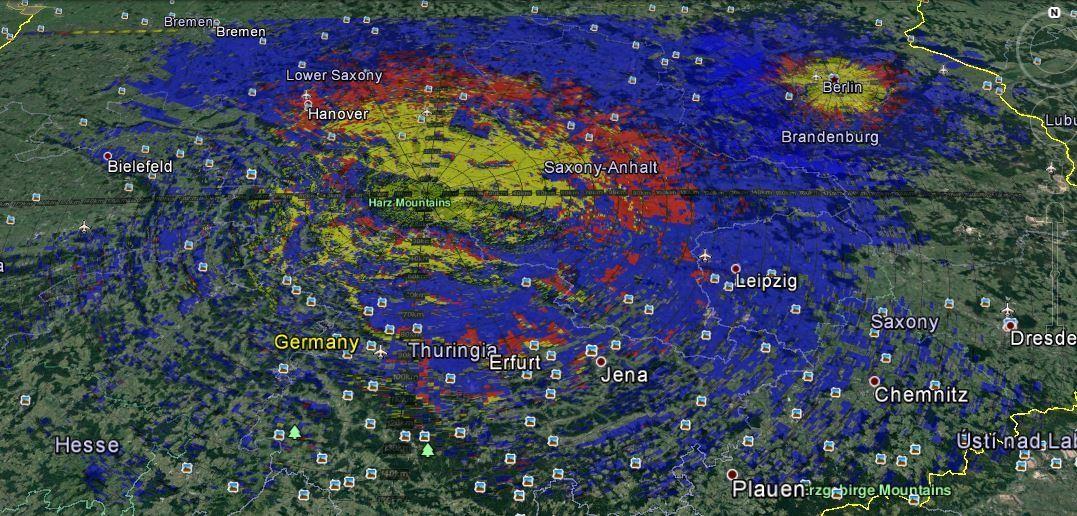
Source: Elaborated by the authors.
The map shows the coverage of two TV stations located in the German Democratic Republic. The inner German border ran through the Harz Mountains: the FRG territory was on the west side of it and the GDR on the east side. It is possible to see that a big part of former the FRG was covered by stations located in the GDR, as described below in details.
Picture 2: Coverage map – Brocken, Channel 6
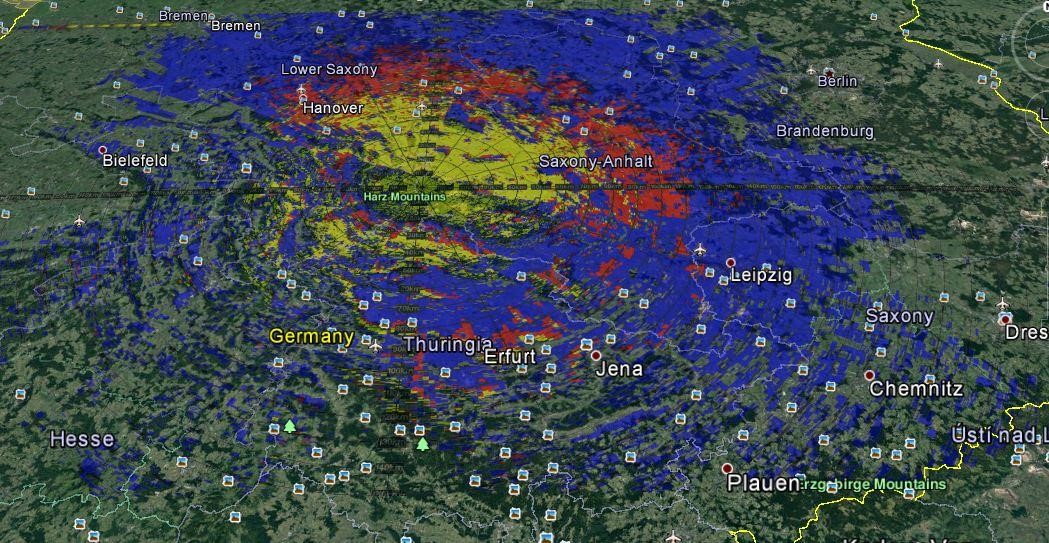
Source: Elaborated by the authors.
Now Brocken is a famous destination for tourists interested in hiking and winter sports. It is the highest summit in the Harz Mountains and it was also the highest point of the former GDR, with an elevation of more than 1.1 thousand meters. The whole range of the mountains was located in the states of Lower Saxony, Saxony-Anhalt and Thuringia – the last two located in the GDR. One of the most important stations of the country was located in Brocken – channel 6, with a power of 100 kW ERP.
Due to its privileged location, in the highest point of the country, and to the technical conditions of the station, its signal could be watched 100 km from the border of both countries. In the FRG, it reached large cities like Hanover (ca. 500 thousand inhabitants in 1987, according to the countries’ census concluded that year), Bremen (more than 533 thousand) and Bielefeld (more than 305 thousand), as well as some medium and small-sized ones, like Kassel (ca. 187 thousand) and Soltau (ca. 20 thousand). The signal also reached the neighbourhood of Berlin, but the former capital of (unified) Germany and capital of the GDR was covered in a very efficient way by another station.
Picture 3: Coverage map – East Berlin, Channel 5
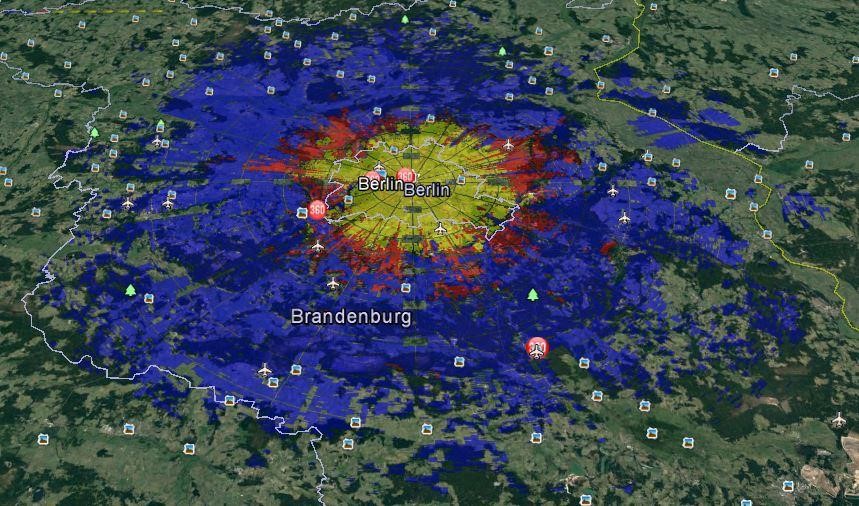
Source: Elaborated by the authors.
In the east part of the most famous German city, Berlin, channel 5 operated with a power of 100 kW ERP. It covered the centre and the north of the state of Brandenburg and even crossed the border of Poland. But its main purpose seemed to be the coverage of both sides of the city separated by the wall. Approximately 2 million people living on the West part of the city received the signals of DFF perfectly.
Yugoslavia
Picture 4: Coverage map – TV stations in Yugoslavia (Slovenia)
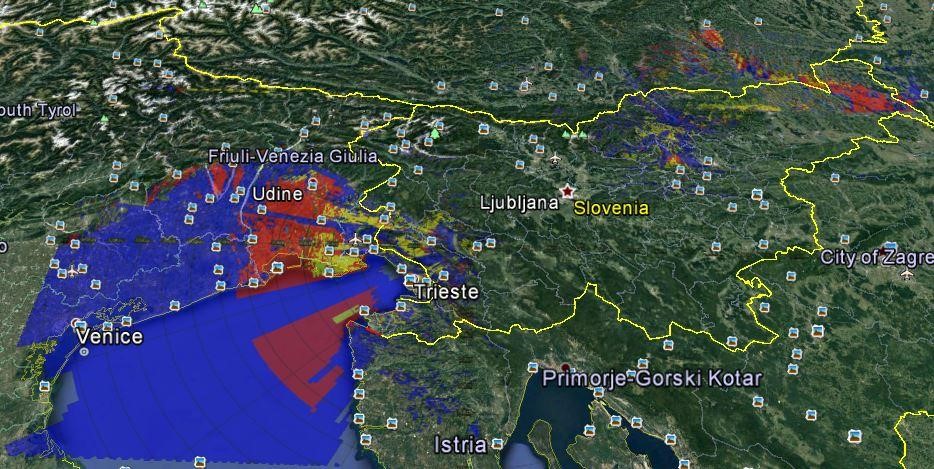
Source: Elaborated by the authors.
The map shows Slovenia, the northern Republic of Yugoslavia. On the west Slovenian western borders, Italy and Trieste – Zone A, part of the Istria peninsula and a region also considered Italian territory; Austria on the north; on the south and east Croatia, another Republic of Yugoslavia; and, on the northeast, Hungary. On the map, it is possible to recognise three different stations, which are described below.
Picture 5: Coverage map – Nanos, Channel 6
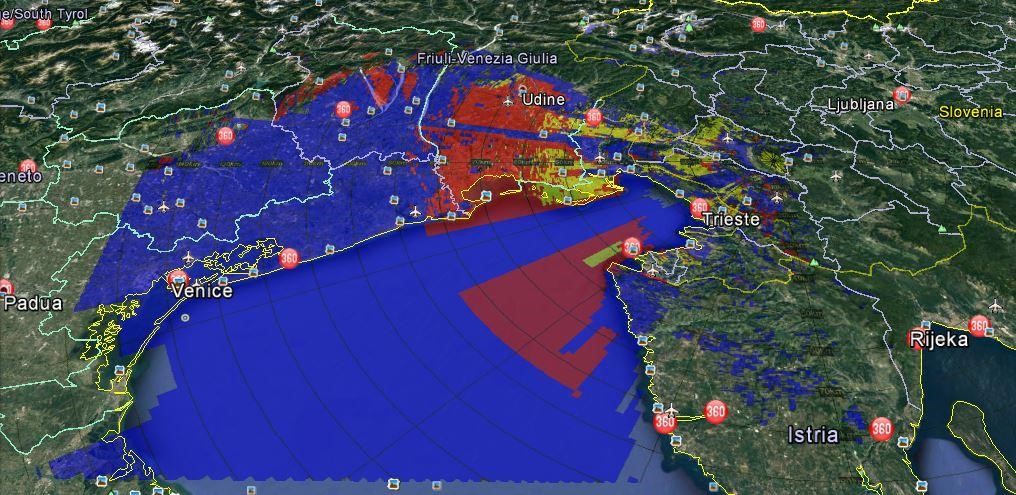
Source: Elaborated by the authors.
On the west part of Slovenia lies Nanos, a mountain plateau with the altitude of around 1.2 thousand meters. In the 1960s, the government installed a facility on the top of Nanos to transmit radio and TV stations. One of these was channel 6 with a power of 35 kW. In the 1990s, the facility was attacked during the war for Slovenian independence.
Due to the Adriatic Sea, located on the west of Nanos, TV signal could reach huge distances. In Italy, it was possible to watch Yugoslavian TV not only in cities like Gorizia (around 38 thousand inhabitants, according to 1991 census) and Monfalcone (27 thousand) located near the border of both countries but also in bigger cities in further distance from the border, like in Udine (99 thousand), Treviso (83 thousand) and Venezia (309 thousand). The signal reached even Mira (36 thousand), located on the west of Venezia.
Picture 6: Coverage map – Pohorje, Channel 11
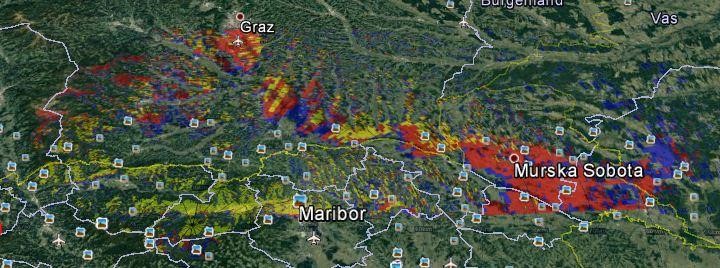
Source: Elaborated by the authors.
Another Slovenian station was located on the group of the mountains called Pohorje, near the cities of Dravograd and Maribor. Channel 11 operated with a power of 35 kW. The signal crossed the border with Hungary and reached, for example, part of the town of Lenti (around 8.7 thousand inhabitants, according to 1990 census). But one more important aim of the channel seemed to be to reach Austria: the signal crossed the southeast of the country to the district of Graz. Although it did not reach the city of Graz (quite 238 thousand inhabitants, according to 1991 census), it covered some towns near it, like Lieboch (3.3 thousand) and Hitzendorf (5.7 thousand) and other located in the south from them, like Leibnitz (10.1 thousand) and Lebring (1.6 thousand). The signal of channel 11 also spread to Deutschlandsberg District, covering towns like Wies (5 thousand) and Stainz (7.6 thousand).
Picture 7: Coverage map – Plesivec, Channel 6
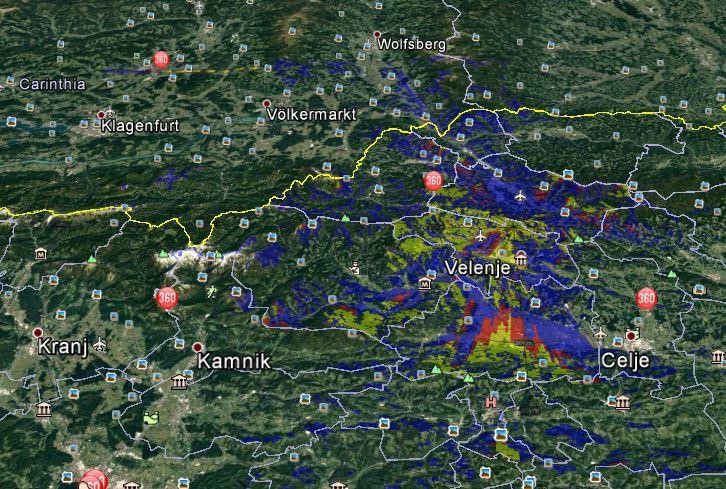
Source: Elaborated by the authors.
The third station presented in Slovenian map was located in Plesivec, a settlement that is part of the city municipality of Velenje, in the north of the country. From there, channel 6, operating with a power of 35 kW, also reached Austria. In this case, the covered area was located on the west of the one covered by Pohorje station. Channel 6 reached Austrian cities like Lavamünd (around 3.8 thousand).
Finally, a local TV service was established in the town of Koper, known in Italian as Capo d’Istria. Technical details of this station were not available but literature points out that the programme reached Italy. In the early 1970s, it already broadcasted in colour and this was a novelty for Italian watchers limited to RAI. The audience seemed to be considerable, at least until the opening of Italian TV market to new private stations. In the beginning of the 1990s, the TV Koper – Capo d’Istria lived a new important phase (for Italian audience) with a programme dedicated to sports events (Hay, 1993; Bartolj, 2006).
Picture 8: Coverage map – Pelister, Channel 4
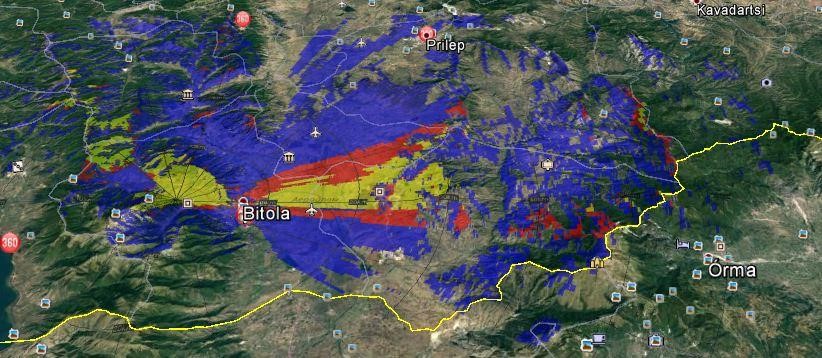
Source: Elaborated by the authors.
Macedonia was the southern Republic of Yugoslavia. Pelister Park is located in the municipality of Bitola and, more specifically, on the Baba Mountains. Its peak, called Pelister, has an altitude of 2.6 thousand meters. A transmitter located there operated in channel 4 with a power of 30 kW. Its signal crossed the border between Macedonia and Greece, reached the region of Órma in this country, but apparently did not cover any city.
Bulgaria
Picture 9: Coverage map – Botev Vrah, Channel 11
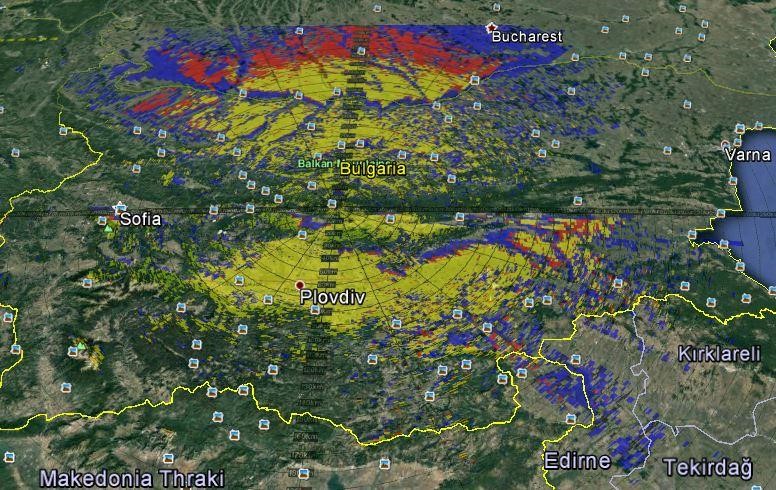
Source: Elaborated by the authors.
Botev Vrah, a mountain with an altitude of 2.3 thousand meters, is located quite in the centre of Bulgaria. The transmission facility located there can cover more than half of the country and transmit even to the neighbouring countries, depending on its power. In 1989, channel 11 operated with a power of 250 kW.
The Bulgarian TV programme could be watched in Bucharest, the capital of Romania (with around 2.1 million inhabitants, according to 1990 census). The signals coming from Botev Vrah could also be received in two more countries in the south: in Greece and Turkey. In the first one, Orestiás (around 15 thousand inhabitants, according to 1991 census) was one of the covered cities. In Turkey, the programme could be watched more than 100 km from the border in the near of Edirne (around 102 thousand, according to 1990 census) and in small villages and towns like Bosna, Üyüklütatar, Karacas, Doyran, Elcili, Serbettar, Ömerbey, Süleymaniye, or Aydinköy.
It is important to mention that the power of 250 kW used in Botev Vrah was a unique for Bulgaria. Other high-power stations in the country located, for example, in Sumen and Burgas operated with 100 kW.
Hungary
Picture 10: Coverage map – Sopron, Channel 9
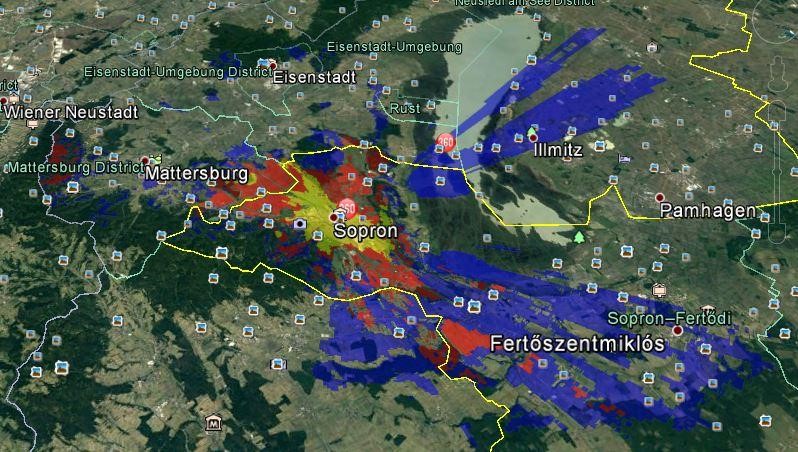
Source: Elaborated by the authors.
Sopron is a Hungarian city located very near the Austrian border. In 1989, channel 9, with a power of 5 kW, covered towns and villages located across the border, like Schattendorf (around 2.5 thousand inhabitants, according to 1991 census), Baumgarten (a village of 864 inhabitants) and Klingenbach (1.1 thousand). In northwest direction, the signal almost reached Wiesen (2.6 thousand) located 25 km from the border. In northeast direction, channel 9 covered Illmitz (2.5 thousand) and Frauenkirchen (2.6 thousand) located 17 km from the border.
Czechoslovakia
Picture 11: Coverage map – České Budějovice, Channel 2
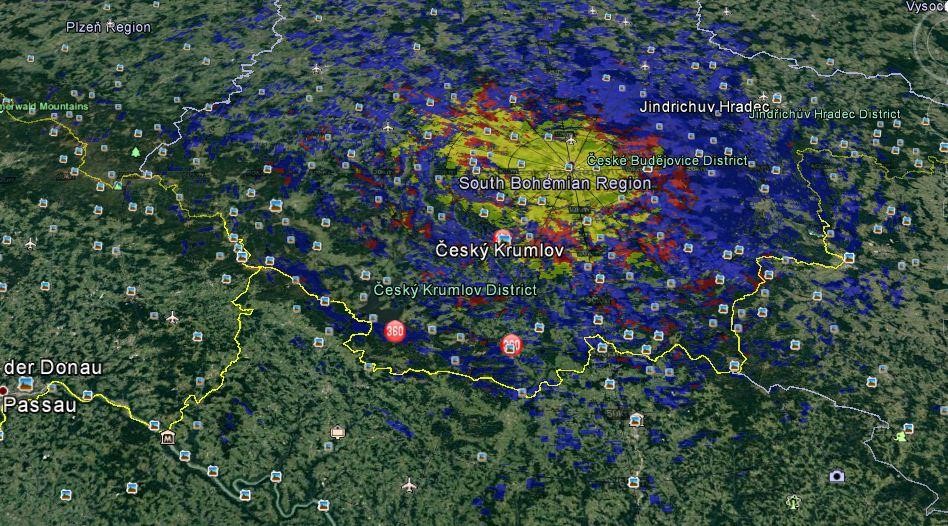
Source: Elaborated by the authors.
České Budějovice is the largest city in South Bohemian Region of the former Czechoslovakia. Channel 2 transmitted from this city with a power of 100 kW. A low channel with high power can always theoretically reach a very good distance – and this can be seen in the previous map.
The channel was able to cover most of the southern cities of the country, as well as some German regions, apparently without reaching any major city. It also reached the northern part of Austria, covering some towns located near the border, like Grünbach (around 1.6 thousand inhabitants, according to 1991 census).
Picture 12: Coverage map – Cheb, Channel 26
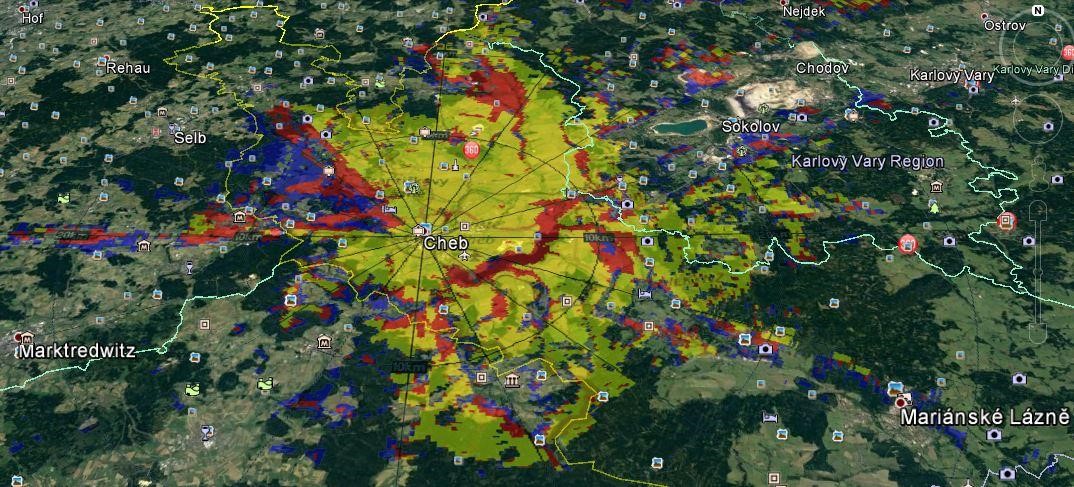
Source: Elaborated by the authors.
Another Czechoslovakian station was located in Cheb, a city quite in the border with Germany. From there, channel 26, operating with a power of 40 kW, reached German villages located in the distance of less than 20 km, such as Thiersheim, Hohenberg an der Eger (1.6 thousand inhabitants, according to 1995 census), Mammersreuth, Querenbach, and Hatzenreuth.
Albania
Picture 13: Coverage map – Gjirokastër, Channel 7
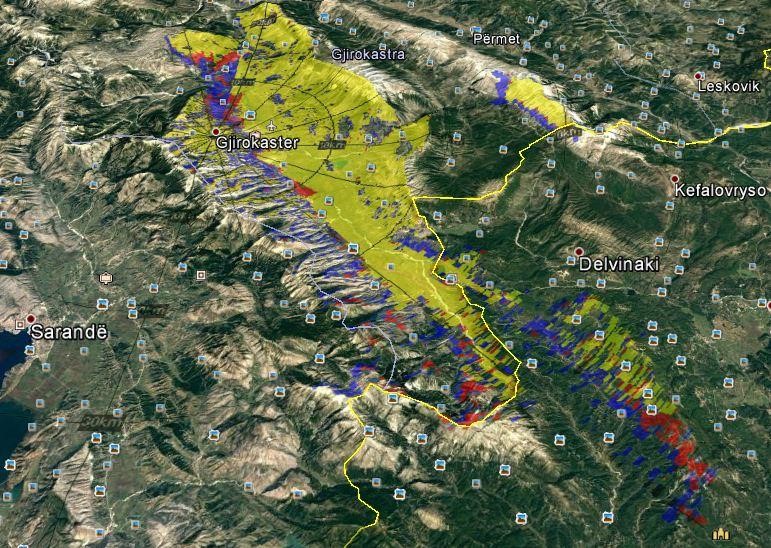
Source: Elaborated by the authors.
The map shows the station located in the city of Gjirokastër, Albania. Channel 7 operated from this city, with a power of 10 kW, and reached not only the southern part of the country, but also the far north of Greece. Some small villages there, like Aetopetra (with 144 inhabitants, according to 1991 census) and Kournorrachi, could receive the signals coming from Albania.
In the previous sections, this paper reiterated some aspects related to broadcasting in the former socialist bloc and tried to demystify another one. The first of them, as pointed out by some authors mentioned above, is the current consensus regarding the history of TV in the socialist bloc. Old images of political leaders speaking to effusive crowds, military parades or any other type of explicit propaganda were common for part of the programmes, in variable amount depending on the country and on the period analysed. But this is just part of the truth: even entertainment was a key point for many broadcasters, since TV had to attract and preserve audience. After all, this statement was publicly defended by political leaders.
Another aspect is related to the strength of TV in the socialist bloc. At least in the most developed countries of this group, the mass media operated in the 1980s with full capacity, with a total transmission time similar to other European capitalist countries. In terms of total transmission time, for example, Yugoslavia (Slovenia), the GDR, Czechoslovakia and Poland can be compared to Greece, Portugal and Italy.
Literature often focuses on the role of mass media from capitalist countries transmitting their programmes to the socialist bloc to spread supposed democratic ideals and to show the way of life in the other bloc. How did the socialist countries react? Two answers are often mentioned in the literature: radio jamming aiming to avoid reception of signals coming from the west, and increase of investments in the production of better programmes.
The third answer was the main focus of this paper. The socialist bloc did not simply (try to) resist or dispute domestic audiences – as we argue above, in some countries, at least in the late 1980s, the local broadcasters counterattacked and transmitted to foreign countries. An obvious question emerges at this point: did the East European governments and, consequently, the state-owned TV stations really want to broadcast their programmes to capitalist Europe or was this an unintended technological consequence?
The dispute between DFF and ARD/ZDF in the GDR and the FRG – although also being partners in content exchange – was an exception. The objective of reaching the neighbouring country, in this case, has already been discussed by many researchers, some of them cited in this paper. The presented coverage maps of DFF (pictures 1, 2 and 3) showing that its signal reached the FRG are in line with this interpretation.
Other situations were less discussed, without any publicly (at least online) available official documents supporting them. This does not mean, however, that the mentioned counterattack was not planned. Actually, we believe that there is the evidence obtained through analysis of the coverage maps suggesting that at least the GDR, Yugoslavia (and specifically Slovenia) and Bulgaria targeted transmissions deliberately to the neighbouring countries.
This conclusion is based on the technical conditions of the studied stations. They were installed in high mountains, like Brocken, Nanos and Botev Vrah; they operated in the VHF frequency (channels 6 and 11); and, except for the last one, they were located near the state borders. These aspects always contribute theoretically – and in practice, in these cases, as shown – to amplify the reach of TV signals. So, the mission of reaching neighbouring capitalist countries was successful, although the practical influence of these transmissions is still not clear.
It is important to mention some other different technical conditions of these stations, if compared to others located in the same countries. For example: the station located in Nanos (picture 5) reached only a small part of Slovenia and was dozens of kilometres away from larger cities (such as Ljubljana and Maribor) but it covered a considerable part of Italy; and the power used in Botev Vrah (picture 9) was in no way comparable to other Bulgarian TV stations.
In other cases, presented in this paper, the suggestion of a counterattack from socialist mass media is not very clear. TV signals crossed the national borders but did not reach big cities or explicit strategic points on their way. Nonetheless, it was possible for the neighbouring countries to receive the signal with technical adaptations of TV sets that were commonly put in practice, or via multi-standard Secam-PAL TV sets.
These available multi-standard TV sets and the common knowledge about technical adaptations allow us to conclude that TV signals could really be received, i.e., that programmes were at disposal to be watched by population in West Europe despite differences regarding the Secam and PAL standards. The purchase of multi-standard TV sets, which were very common in the 1980s, was the easier way to receive the signals. But since the implementation of technical adaptations in older TV sets was common in East Europe, there were no technical difficulties to proceed in the same way with TV sets in West Europe.
One further topic related to the programmes is not covered by this paper (though it can complement it): did the programmes explicitly focus, in some way, on foreign audiences? Were they partly translated in other idioms or did they debate themes that were expected as interesting for foreigners? Other important debate is related to the audience: what was the market share of socialist channels in capitalist countries? Until the present, TV audience measurement is not reliable in some countries, so probably it would be difficult to give a safe and precise answer considering the 1980s situation. If further researches look for and find answers to these questions, they will help to understand the real limits of influence of socialist TV programmes in capitalist countries.
Hopefully this paper contributes to clarify another dimension of the Cold War. Mass media served as one of the weapons used at that time to conquer “brains and hearts,” as commonly said. Even the defeat of the socialist bloc is partially attributed to the role played by TV and radio operating in and from capitalist countries, as already mentioned in this paper. This is a real part of the story. But the socialist bloc and its media were not helpless victims. TV stations from some of these countries not only resisted, but also possibly tried a broadcasting counterattack.
Octavio Penna Pieranti received his Ph.D. in administration and Master’s in public administration from the Getulio Vargas Foundation (Ebape / FGV), and Bachelor’s in journalism from the Federal University of Rio de Janeiro (UFRJ). Currently, he works as a postdoctoral researcher at the Faculty of Communication of the University of Brasília (FAC / UnB), emeritus researcher at the Nucleus of Studies in Brazilian Administration (Abras / UFF) and researcher at the Laboratory of Communications and Technology (Lecotec / Unesp).
Edilon Esaú Reis graduated in Electrical Engineering with Emphasis in Electronics and Telecommunications at the National Institute of Telecommunications of Santa Rita do Sapucaí (INATEL) and received MBA in Telecommunications, Engineering of Production, Strategy and Businesses by the Institute of Higher Education of Brasília (IESB), Brazil.
References
Bartolj, J. (2006). The Olive Grove Revolution. Transdiffusion Broadcasting System. Available at: <https://www.transdiffusion.org/2006/04/30/the_olive_grove>. 02 Feb. 2018.
Becker, J. (2004). Lessons from Russia: a Neo-Authoritarian Media System. European Journal of Communication, 19(2), 139-163.
Beutelschmidt, T. (2001). “Alles zum Wohle des Volkes?!”: Die DDR als Bildschirm-Wirklichkeit vor und nach 1989. In: H. Timmermann (Ed.). Die DDR in Deutschland – ein Rückblick auf 50 Jahre. Berlin: Duncker und Humblot. Available at: <http://www.ddr-fernsehen.de/5literaturverfilmungen/ddralsbildschirm.pdf>. 10 Oct. 2014.
Beutelschmidt, T., & Oehmig, R. (2014). Connected Enemies? Programming Transfer between East and West During the Cold War and the Example of East German Television. VIEW Journal of European Television History and Culture, 3(5), 60-67.
Bönker, K., & Obertreis, J. (2016). Introduction. In: K. Bönker, J. Obertreis & S. Grampp (Ed.), Television Beyond and Across the Iron Curtain (pp. 101-113). UK: Cambridge Scholars Publishing, vii-xxxviii.
Brücher, L. (2000). Das Westfernsehen und der revolutionäre Umbruch in der DDR im Herbst 1989. Bielefeld: Universität Bielefeld.
Carelli, P. (2014). Italianization Accomplished. Forms and Structures of Albanian Television’s Dependency on Italian Media and Culture. VIEW Journal of European Television History and Culture, 3(5), 79-87.
Chalaby, J. (2010). Public Broadcasters and Transnational Television: Coming to Terms with the New Media Order. In: P. Iosifidis (Ed.), Reinventing Public Service Communication: European Broadcasters and Beyond (pp. 101-113). London: Palgrave Macmillan.
Dittmar, C. (2005). Television and Politics in the Former East Germany. CLCWeb, 4(7).
Hay, J (1993). Invisible Cities/Visible Geographies: Toward a Cultural Geography of Italian Television in the 90s. Quarterly Review of Film & Video, 14(3), 35-47.
Heimann, T. (2006). Television in Zeiten des Kalten Krieges. In: T. Lindenberger (Ed.), Massenmedien im Kalten Krieg: Akteure, Bilder, Ressonanzen. Köln: Böhlau Verlag.
Imre, A. (2012). Adventures in Early Socialist Television Edutainment. In: T. Havens, A. Imre & K. Lustyik (Ed.), Popular Television in Eastern Europe During and Since Socialism (pp. 30-46). New York: Routledge.
Jakubowicz, K. (1994). The Audiovisual Landscape of Central and Eastern Europe: Change All Around. In: K. Jakubowicz & P. Jeanray (Ed.), Central and Eastern Europe: Audiovisual Landscape and Copyright Legislation. (pp. 13-20). Antwerpen: Audiovisual Eureka.
Kochanowsky, K., Trültzsch, S., & Viehoff, R. (2012). An Evening with Friends and Enemies: Political Indoctrination in Popular East German Family Series. In: T. Havens, A. Imre & K. Lustyik (Ed.), Popular Television in Eastern Europe During and Since Socialism (pp. 81-101). New York: Routledge.
Krasner, S. D. (1991). Global Communications and National Power: Life on the Pareto Frontier. World Politics, 3(43), 336-366.
Kresic, H. (2012). Croatia: the Price of Corruption. Oxford: University of Oxford.
Leal Filho, L. L. (2008). Vozes de Londres: Memórias Brasileiras da BBC. São Paulo: EdUSP.
Lepp, A., & Pantti, M. (2012). Window to the West: Memories of Watching Finnish Television in Estonia during the Soviet Period. VIEW Journal of European Television History and Culture, 2(3), 76-86.
Marinescu, V. (1995). Romania: Private versus state television. Javnost-The Public, 2(3), 81-95.
Mihelj, S. (2012). Television Entertainment in Socialist Eastern Europe: Between Cold War Politics and Global Developments. In: T. Havens, A. Imre & K. Lustyik (Ed.), Popular Television in Eastern Europe During and Since Socialism (pp. 13-29). New York: Routledge.
Mihelj, S. (2014). Understanding socialist television: Concepts, objects, methods. VIEW Journal of European Television History and Culture, 3(5), 7-16.
Mustata, D. (2011). The Power of television: including historicizing of the Live Romanian Revolution. Utrecht University.
Mustata, D. (2012). Television in the Age of (Post) Communism: The Case of Romania. Journal of Popular Film and Television, 40(3), 131-140.
Reifová, I. (2015). A study in the history of meaning-making: Watching socialist television serials in the former Czechoslovakia. European Journal of Communication, 30(1), 79-94.
Rolandi, F. (2015). A Filter for Western Cultural Products: the Influence of Italian Popular Culture on Yugoslavia – 1955-65. In: S. Mikkonen & P. Koivunen (Ed.), Beyond the Divide: Entangled Histories of Cold War Europe. Oxford: Berghahn Books.
Sharp, F. (2012). Philips 26P1195 Multistandard year 1982. Obsolete Technology Tellye! Available at: <http://obsoletetellyemuseum.blogspot.com.br/2012/08/philips-26p1195-multistandard-year-1982.html?m=1>. 03 Feb. 2018.
Surugiu, R. (2017). Exploring the Role of Romanian Television in Public Sphere (1957-1989). The European Proceedings of Social & Behavioural Sciences, XXVII, 771-779.
Vivanco, J. V. (2006). Piratas en el Éter: la Guerra Radial contra Cuba 1959-1999. La Habana: Editorial de Ciencias Sociales.
World Radio TV Handbook – WRTH. (1990). Amsterdam: Billboard.
[i] It is important to mention that this paper adopted the terminology “socialist,” instead of “communist,” in respect to one of Marxist classical approaches of this discussion considering socialism a step of the construction of communism. It is not the aim of this paper to problematize this discussion, though.